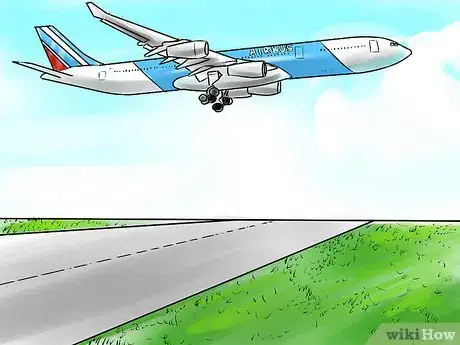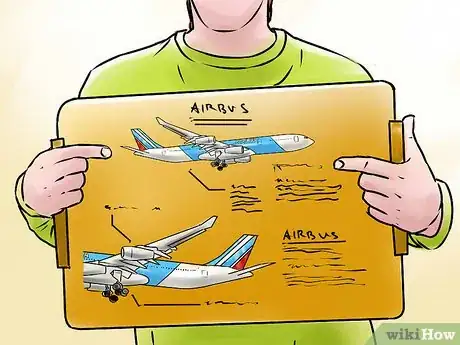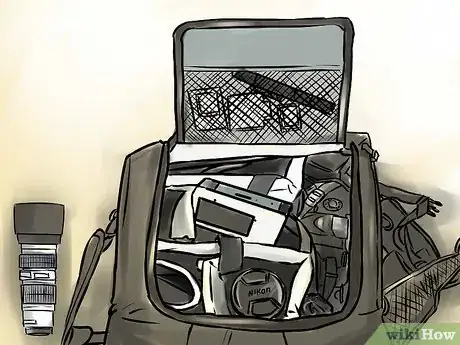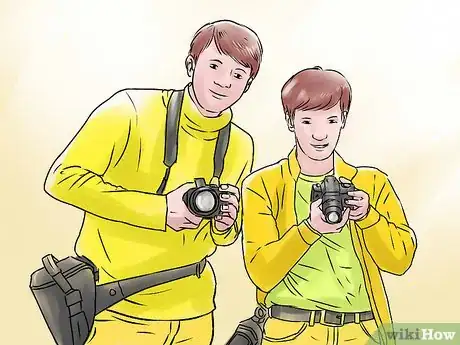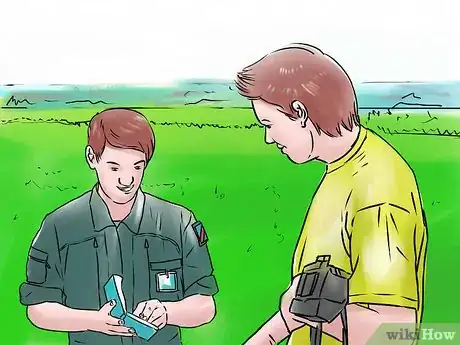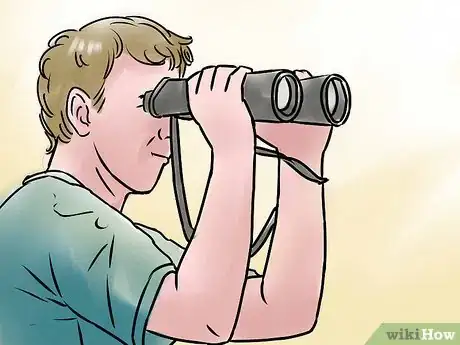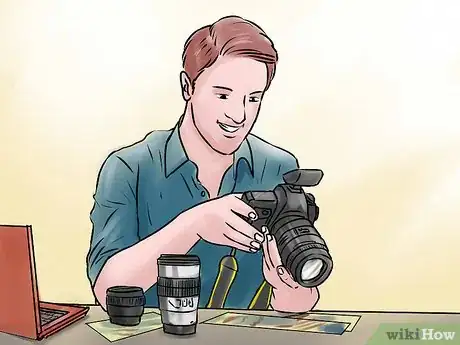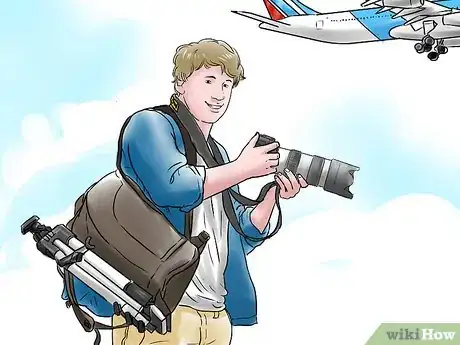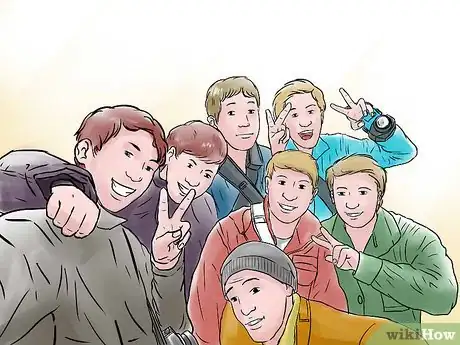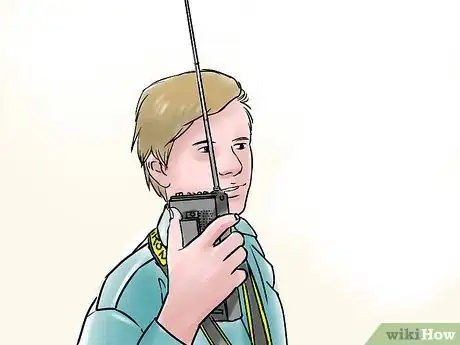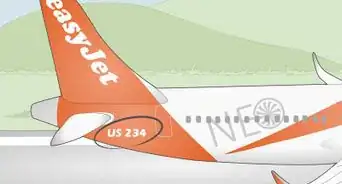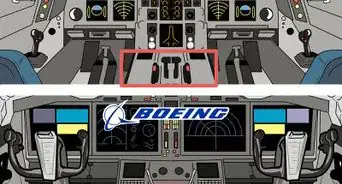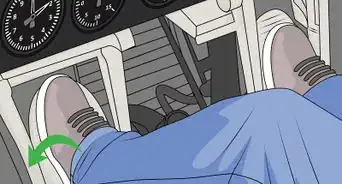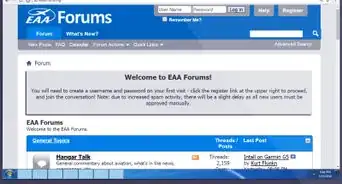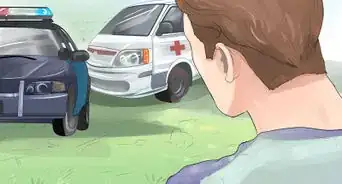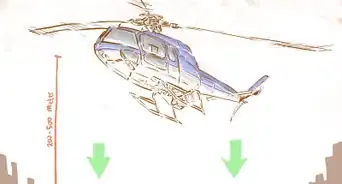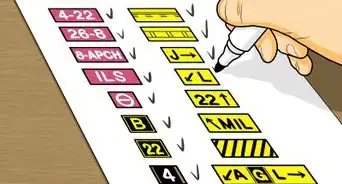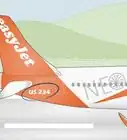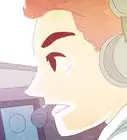wikiHow is a “wiki,” similar to Wikipedia, which means that many of our articles are co-written by multiple authors. To create this article, 34 people, some anonymous, worked to edit and improve it over time.
There are 9 references cited in this article, which can be found at the bottom of the page.
This article has been viewed 222,746 times.
Learn more...
Aircraft spotting, also known as plane spotting, is a popular pastime worldwide. As a hobby, it brings a number of enjoyable elements for the participant, including getting outdoors, making meticulous observations, "collecting" without creating clutter, having a good excuse to use your really fancy digital camera equipment, and finding a great way to get together with like-minded enthusiasts. Aircraft spotters have an eye for detail and are keen to find out as much as possible about aircraft. If you're keen about planes, flying, facts, and you remain constantly amazed by the ingenuity of human ability at getting a great tin bird up into the sky, aircraft spotting may just be the perfect hobby for you!
Steps
-
1Make a decision as to the extent of aircraft that you might like to "spot". Although the often used term "plane spotting" refers to airplanes, the preferred term is "aircraft spotting" because you can observe and record any number of flying craft and not just airplanes. For example, helicopters, gliders, balloons, airships, and microlights can be included if wished.[1] You might want to narrow the choices if you live somewhere that has an incredible amount of air traffic, such as London, Chicago, Frankfurt, etc., or you might want to include a wider range of aircraft if you're living in the middle of empty airspace where aircraft arrivals are not so frequent, such as the country, outback, or the Arctic region. It's really up to your time availability and personal interests.
- Start by doing some background research on aircraft spotting websites. There are many sites dedicated to aircraft spotting, from the amateur blog to the professional club-sponsored site, and they can all open up new ideas for your hobby.
- When searching for online information about aircraft spotting, also use the term "plane spotting", as it is used frequently as well.
- When looking for information online, also look for airports, aircraft manufacturers, airline information, flight pathways, etc., as these will provide you with a great deal of useful background information. You can limit the search to your own country, or check different sites from all around the world.
- Keep in mind that aviation photography is a hobby in its own right, and dovetails perfectly with aircraft spotting. So, if anyone questions your interest, you can always justify it by explaining that you are an aviation photography hobbyist as well!
-
2Understand what is usually involved in aircraft spotting. Although you are free to spot aircraft in any way that pleases you, there are some standard practices that aircraft spotters tend to follow. In order to work out the type of aircraft, there are many indicators that assist the aircraft spotter in working this out. In addition, even where the type of plane is evident, there are still many other elements worth noting, including country of origin, age, and any special modifications. Things to note as an aircraft spotter include:[2]
- Noting the type of plane. Its make, size, colors, and country of origin can all be of interest.
- Noting the plane's registration details. This might enable you to discern the delivery or launch dates of the particular aircraft, depending how much detail you want to go into.
- Noting any interesting artwork or insignia features on a plane (for example, some airlines like Qantas paint the tail wing, or the whole aircraft, using special artwork from renowned artists on certain planes). For military aircraft, camouflage markings are important and these will differ from country to country. There might also be squadron badges and code letters.
- Noting engine noise, vapor trails.
- Placement of wings - is it a monoplane, biplane, or triplane. How are the wings placed in relation to the fuselage, and how much do they sweep rearwards?
- Is it a recent aircraft, or a vintage model?
- Noting whether it has retractable wheels or a fixed undercarriage. Or is it a seaplane?
- Noting the speed.
- Noting cockpit placement.
- Noting the landing or take-off pattern of the plane.
Advertisement -
3Get some good gear. Here is your excuse to indulge in good quality gear guaranteed to enhance your aircraft spotting experience. Some items to consider include:
- Decent binoculars - for checking out incoming aircraft angles, for noting registration numbers, marks and details, for outdoing your mate at seeing things first, good binoculars are a must. You can also purchase a "spotting scope" instead of binoculars, if preferred.
- Digital camera, plus telescope lens, tripod, etc. - for photographic records of the aircraft you have spotted. This is especially important if you are keeping a personal digital album record of your spots, or if you're contributing your spots to a website.
- Fold-up chair, thermos flask, snack container, rug and warm clothing if cold, sunscreen and hat if hot, snacks and drinks - it's important to be comfortable and to keep well hydrated and fed!
- Manuals or guides if you want to work out what the aircraft is. You will need to consider both commercial aircraft manuals or guides and military aircraft manuals or guides unless you're not likely to see military aircraft, in which case, only commercial aircraft manuals will be needed. Ask at your local library or look online - some online auction sites can be a good source of such manuals, or sites dedicated to aircraft spotting.
- A dedicated notebook and decent all-weather pens for writing down the information you glean from spotting. A weatherproof notebook available from camping stores is a good idea.
- A safety jacket. While not essential, if you are able to spot somewhere that could potential be hazardous for you if you're not seen, consider getting a safety jacket. This might be useful even if your only hazardous element is crossing a very busy main road to get to your spotter's paradise.
-
4Take a buddy. It's a lot more fun if you're doing this with someone you know and who appreciates your enthusiasm for aircraft spotting too. If you have a buddy, both of you can chat and set up your own spotting competitions between you. Take walkie-talkies and sit in different locations to see who can spot the registration first. Award yourself points, with the winner or loser shouting a meal or drink after the day's spotting, depending on how you like to play it!
-
5Prepare yourself for an aircraft spotting trip. Initially, it is a good idea to team up with somebody who has already done aircraft spotting so that they can take you to the best places and give you pointers throughout the session. If not, look online, or ask around, to find suitable places to go aircraft spotting. Some airports or aviation associations are very helpful and suggest spotting places for enthusiasts.[3]
- Always consider safety first. Don't go where you're not allowed. There are strict rules about getting too close to airports, even if they're not fenced off. On the whole, those rules are for your own safety but they're also about security, particularly in more security conscious countries.
- Set up your spotting area with consideration for existing spotters. If you are somewhere used traditionally for spotting, it's probably not wise to just assume it's OK to sit just anywhere. Ask for advice from the other spotters and they'll usually be very happy to make suggestions for you.
-
6Start spotting. If you've already worked out from the previous steps what you're looking for, then start observing for those elements as you're spotting. Otherwise, you might to ease yourself into the aircraft spotting experience by simply observing everything initially and deciding from this experience which elements interest you most. This is why it can be helpful to have someone already well versed in spotting nearby, to give you hints and guidance so that you don't feel overwhelmed by the initial spotting experience.
-
7Record your experiences once back at home. While on your outing, you will be taking notes and photos which will need sorting once back home. Plan to set aside some time to tidy up, collate and reference your findings. This might include:
- Selecting the best aircraft photos for uploading to a website.
- Noting significant features or things of interest that you saw during the aircraft spotting exercise.
- Tallying up the aircraft spotted.
- Marking down the aircraft you've not spotted before, as well as making notes of aircraft you still would like to be able to check off in the future.
-
8Decide how far you want to take your new hobby. There are many possibilities and some of them may be more appealing than others. For starters, it is a good idea to consider how you feel about the following ideas as forming a part of your hobby, or not, as the case may be:
- Competing with other aircraft spotters. This can include joining a club or association and aiming to spot all types of aircraft in a class that is determined by the club or association.
- Creating your own website and uploading your photos of spots onto it, along with commentary.
- Uploading your photos of spots onto one of the many aircraft spotting websites already online. This can be a combination of competition and hobby if wished, or just serve as a source of displaying your photos as wished. If you do this, be sure to keep note of the date, time, and place of your spot, as many sites record the "last spot" of each aircraft as a way of keeping track of the aircraft for all interested viewers.
- Joining spotting mail lists. There are a number of these that you can join to be kept informed. There are now also Twitter accounts you can follow to keep up with spotting information.[4] Find out if your local club or association, or your favorite aircraft spotting websites, have Twitter accounts that you can follow.
- Broadening your hobby to include what are "ancillary activities", such as listening to air traffic transmissions (this can be done using radio scanners but only where it is legal to do so).
- Packing your bags and getting on a plane to go and spot more planes somewhere else in the world. If you have spent time cultivating friendships with other aircraft spotting enthusiasts around the world, this can be a fun and exciting way to make holiday plans and to make new friends. There are plenty of sites dedicated to explaining where the best places for aircraft spotting are to be found around the world. Just be understanding that if you drag along the family though, they're unlikely to want to spend their holiday pursuing your passion, so have something more interesting planned for them!
- Visiting aviation museums around the world. This can also be adding to your aircraft spotting records, as you check off vintage and famous aircraft from different parts of the world.
-
9Consider joining a club or association that supports and promotes aircraft spotting. A hobby is always a lot more fun when you share it with other like-minded enthusiasts and being part of an excited and active group is a great way to give real life to your hobby experience. For example, you can join the LAAS International as an aircraft enthusiast. [5]
-
10Be useful. As your hobby continues, if you notice anything that you believe should be passed on to airport officials, then be helpful and do so. This doesn't mean being a nuisance and trying to suppose you know their job better than they do, but some things that could be helpful include:
- Alerting airport officials if you notice any bird nesting or animal breeding activities near the airport or on it. Birds and animals can be a hazard for aircraft and it's a good idea to let airport officials know in case they haven't realized.
- Alerting airport officials if you notice any strange activities, or security breaches such as broken fences, etc. Don't be a vigilante though - just things that might be out of the ordinary. For example, in the UK there is a code of conduct in place for aircraft spotters introduced by aviation enthusiasts' club LAAS International, under which aircraft spotters are encouraged to report suspicious behavior. [6]
Community Q&A
-
QuestionAre we allowed to go inside the airport?
 Community AnswerIt depends to which airport.
Community AnswerIt depends to which airport. -
QuestionCan you recommend an aircraft radio that allows me to listen to the pilot and air traffic control?
 Community AnswerUse liveatc.net to listen to live ATC conversations. They also have an app.
Community AnswerUse liveatc.net to listen to live ATC conversations. They also have an app.
Warnings
- Taking along your other half or kids could result in family irritation; be sensitive to their disinterest as the hours of looking up in the sky are not to everyone's taste. Get a reassurance from any family member taken along that they're genuinely interested in the experience.⧼thumbs_response⧽
- Aircraft spotting could get you into legal trouble with your country's government security and/or military authorities who could mistake your new hobby as reconnaissance by foreign spies or terrorists. For example, a lot has changed since the September 11th attacks and the resultant wars for the United States and some of the allied countries, and there are always some countries in the world with a suspicious mindset that won't tolerate anybody claiming they're innocently aircraft spotting. Know the rules of the country you're in and the airport you're spotting near before you start plane spotting - some places are far more understanding than others.⧼thumbs_response⧽
- Stay away from sensitive areas at airports. Follow all instructions from security or airport police. Always have photo ID with you.⧼thumbs_response⧽
- Take warm clothing/wrapping if it's cold.⧼thumbs_response⧽
- If you're in a country that's going through war, don't aircraft spot at all as a hobby because during war, it's a wartime espionage activity.⧼thumbs_response⧽
Things You'll Need
- Waterproof notebook and pen
- Binoculars or spotting scope
- A camera, good lens
- A website (optional)
- A high visibility jacket (optional)
- LAA membership, or similar
- Thermos with hot or cool drink
- Appropriate clothing for warmth
- Blanket if cool
- Foldaway chair
References
- ↑ Wikipedia, Aircraft Spotting, http://en.wikipedia.org/wiki/Aircraft_spotting
- ↑ Wikipedia, Aircraft Spotting, http://en.wikipedia.org/wiki/Aircraft_spotting
- ↑ For example, see the New York Aviation JFK Plane Spotting Guide at http://nycaviation.com/spotting-guides/jfk/
- ↑ For example, see the Twitter page for NYCAviation.
- ↑ LAASI, http://www.laasdata.com/
- ↑ BBC, Plane spotters join terror fight, http://news.bbc.co.uk/2/hi/uk_news/england/london/3682329.stm
- ↑ Aoife Kiernan, Trials of a "Girly" Plane Spotter
- http://www.lightaircraftassociation.co.uk/ – research source
- The neat thing about this glossary is that it is also updated in the online version so that you can learn both the old terms and the modern terms where they diverge. This can be helpful if you are reading old aviation manuals you've scored off eBay.
- Plane Spotting in India : Plane Spotters India
